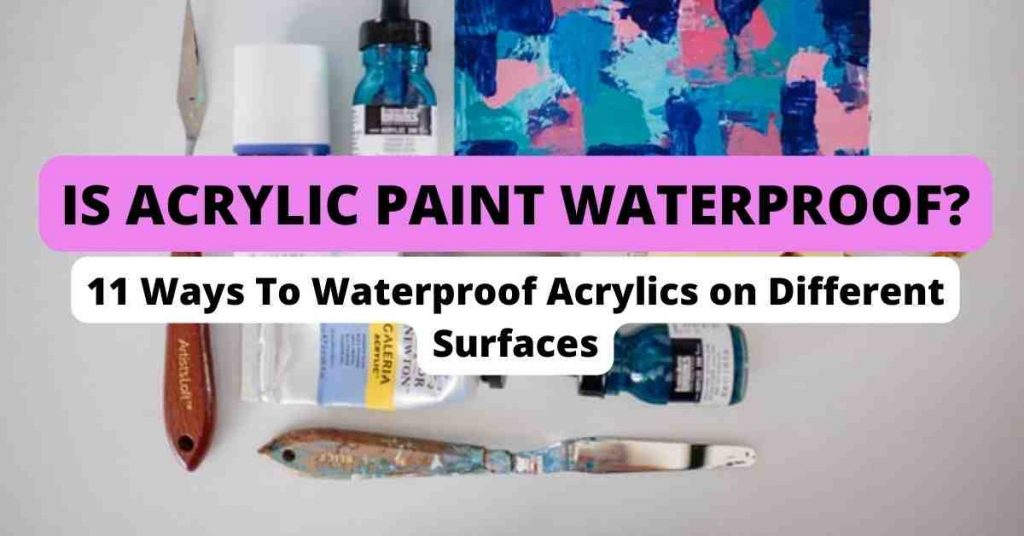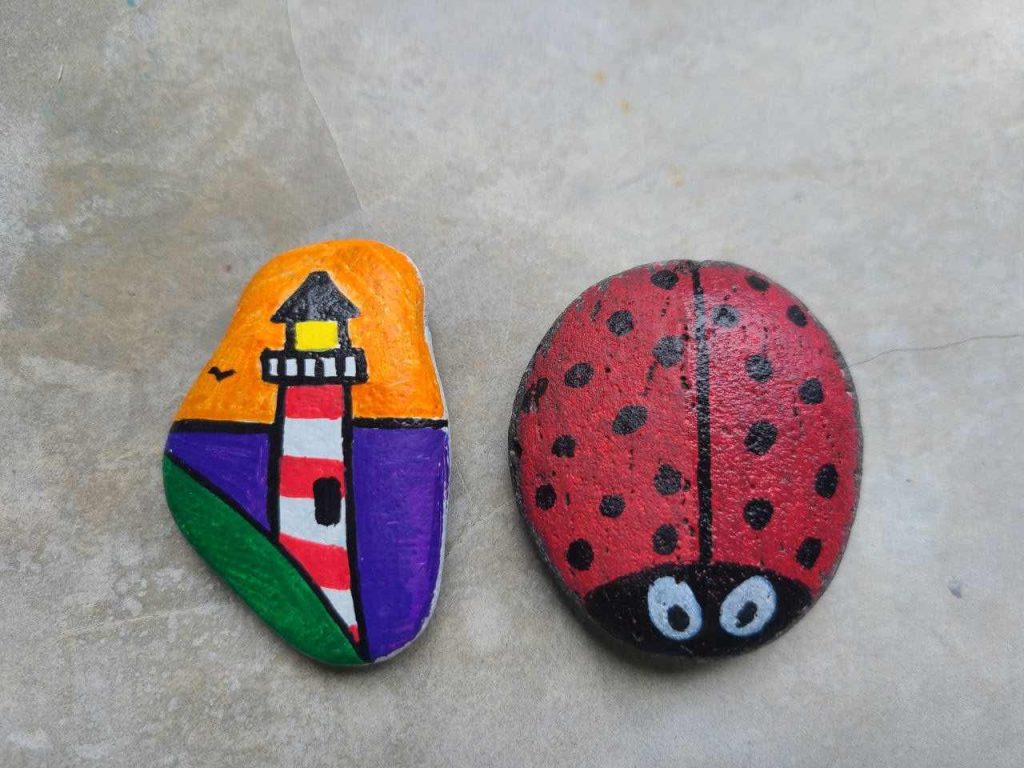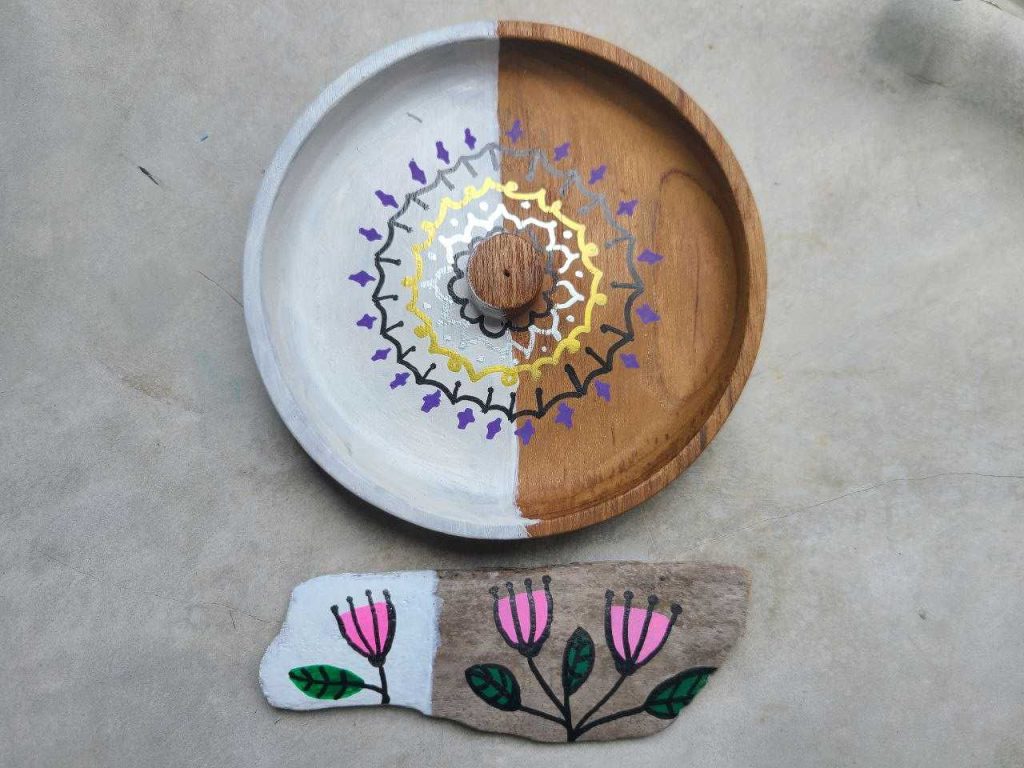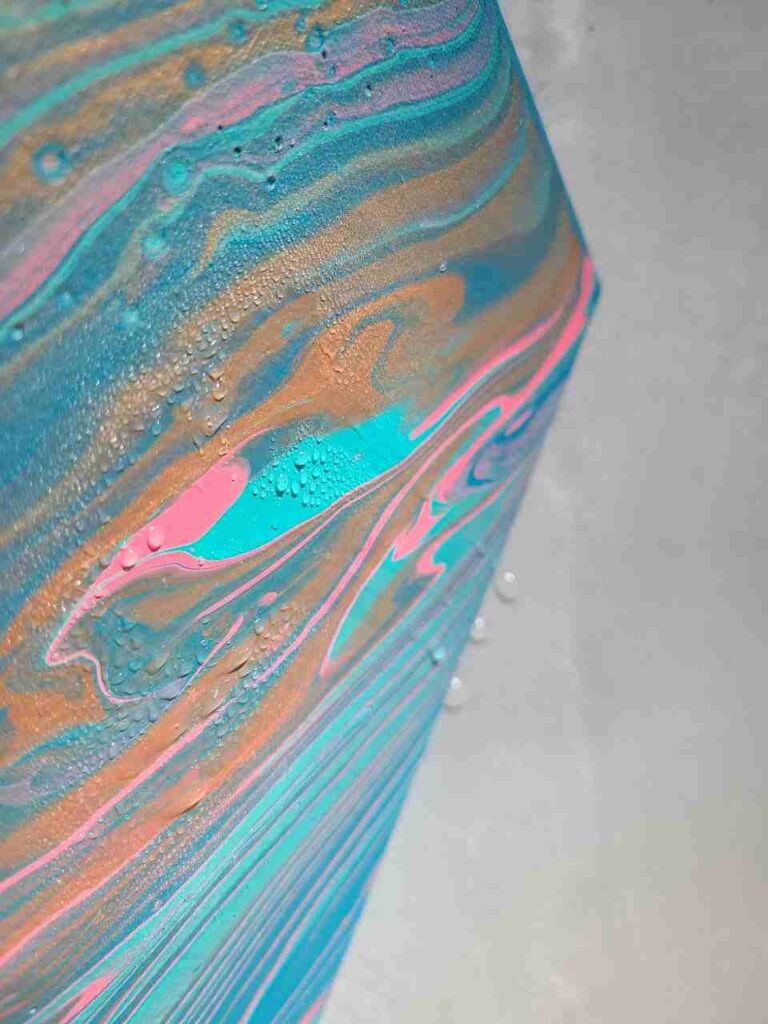Last Updated on March 12, 2024 by Masha Eretnova
Are you worried that the painting you worked so hard for will trickle before your eyes when drenched in water? Well, the good thing about acrylic paint is it is water-based paint.
Many people also choose to use this for different reasons – it is inexpensive and dries quickly. But, what if you accidentally left it to dry outside, and then it suddenly rained? Is this painting going to last? Is acrylic paint, known for being a “strong” paint, indeed waterproof?
No acrylic paint is waterproof, but it is water-resistant once dry. To make acrylic paint waterproof you can apply sealants, varnish, Minwax, or even epoxy.

So, if you want to discover how to properly seal your acrylic paintings, and if you want to know if acrylic paint is waterproof on different surfaces, then read on!
Table of Contents
This article contains affiliate links. It means no extra cost for you but a little commission (2-3%) for me to support my hobby and blog. Thank you!
Is acrylic paint waterproof?
Acrylic paint is water-resistant but not waterproof. There is no acrylic paint brand that is completely waterproof.
Wet acrylic paint is not water-resistant, as the water dilutes the paint. But when the acrylic paint dries on the surface you painted, the acrylic polymer emulsion inside the acrylics forms a film that is water resistant.
Still, anything water-resistant doesn’t immediately mean it’s waterproof.
Below we list answers to popular questions that people have already asked about specific brands.
You will see in the table below if your favorite brand is waterproof or not:
| Brand | Is it waterproof? | Waterproofing acrylic paint |
| Angelus paint | Yes | Finisher + silicone water repellent |
| Arteza acrylic paint | No | Varnish / Minwax/ Epoxy |
| Amsterdam acrylic paint | Yes | Amsterdam varnish |
| Americana acrylic paint | No | Varnish / Minwax/ Epoxy |
| Apple barrel acrylic paint | No | Varnish / Minwax/ Epoxy |
| DecoArt acrylic paint | No | Varnish / Minwax/ Epoxy |
| Daler rowney acrylic paint | No | Varnish / Minwax/ Epoxy |
| Delta creative acrylic paint | No | Varnish / Minwax/ Epoxy |
| Golden acrylic paint | No | Golden varnish |
| Humbrol acrylic paint | No | Varnish / Minwax/ Epoxy |
| Liquitex acrylic paint | No | Liquitex varnish |
| FolkArt acrylic paint | Dishwasher safe Folk Art outdoor – waterproof | Varnish / Minwax/ Epoxy |
| Fevicryl acrylic paint | Yes | Varnish / Minwax/ Epoxy |
| Mont Marte acrylic paint | Yes | Varnish / Minwax/ Epoxy |
| Master’s touch acrylic paint | No | Varnish / Minwax/ Epoxy |
| Winsor and newton acrylic paint | No | Varnish / Minwax/ Epoxy |
| Pebeo acrylic paint | No | Varnish / Minwax/ Epoxy |
| Reeves acrylic paint | No | Varnish / Minwax/ Epoxy |
| Tamiya acrylic paint | No | Tamiya Spray Lacquer |
| Testors acrylic paint | acrylic – no enamel – yes | Varnish / Minwax/ Epoxy |
It just means that though it can go on when accidentally splashed with water, it cannot survive when soaked for a longer period of time.
The normal process of wear and tear will happen if not placed and preserved under the best conditions.
But the good news is, you can make it more durable or “more water-resistant”, for lack of a better term, by sealing it.
There are techniques on how to seal acrylic paintings effectively, which I will share and explain further below.
Before that, let me talk about what many people often asked as well: Is acrylic paint waterproof after it dries?
Acrylic paintings are not waterproof even after it dries, only water-resistant.
To make it even more water resistant, close to being waterproof, you need to prime the surface and seal the paint.
Is acrylic water resistant?

Yes, regular acrylic paint is water resistant when it dries completely.
But wet acrylic paint is not water-resistant nor waterproof. Acrylic paint dries to touch within 10-30 min. When acrylic paint is fully dried there is no water in it, you can add up to 30% water and it will do no harm.
Since acrylic paints are water-based, it makes acrylic paintings water-resistant but not totally waterproof. Water-resistant and waterproof mean two different things and understanding what they both mean matters.
Think of it this way.
If your phone is water-resistant, it can withstand water up to a certain depth, but not when it basically lives underwater.
The water-resistant feature allows it to resist the infiltration of water, but only to a certain degree.
Waterproof, however, makes it impenetrable no matter how long it is being soaked.
Now, you might be thinking, “How about on different surfaces, can it be waterproof even without further sealing it?”
I get it that you want less hassle and with optimum protection for your paintings, so let’s find out if it can be waterproof on different surfaces.
Though acrylic is highly versatile and works for almost any project– glass, windows, and even stained glass– no acrylic paint is completely waterproof.
Sorry to break this to you, but sealing your acrylic paintings to make it more water-resistant is a must.
Below, it will be further explained how acrylic paints react to different surfaces. Like on fabric, metal, rocks, wood, glass, ceramic, concrete, and plastic.
Will there be a difference if acrylic paints are used on a different surface? You’ll find out.
Is acrylic waterproof on different surfaces?
Yes and no. Yes, if it completely dries on the surface and is sealed afterward, but no if it’s still wet. And even after it dries, the acrylic paint may be water resistant but not completely waterproof.
So, you need to seal it with a varnish and other sealants. Plus acrylic paint reacts on different surfaces and for different purposes. Some acrylic paintings need to be placed outdoors.
| Surface | Is acrylic waterproof? | How to make it waterproof |
| Canvas | No, just water-resistant | Varnish it or apply epoxy |
| Fabric, clothes, and shoes | No, just water-resistant | Use a fabric medium |
| Metal | No, just water-resistant | Prime and seal it |
| Rocks | No, just water-resistant | Prime and seal it |
| Wood | No, just water-resistant | Prime and seal it |
| Glass | No, just water-resistant | Prime and seal it |
| Ceramic and clay | No, just water-resistant | Prime and seal it, bake or glaze |
| Concrete | No, just water-resistant | Prime and seal it |
| Plastic | No, just water-resistant | Prime and seal it |
Is acrylic paint waterproof on fabric, clothes, and shoes?
Yes, acrylic paint can become waterproof on fabric, clothes, and shoes if you heat set it.

If you rely on the material alone, you might be disappointed to see that it won’t last long, let’s say years, without using a medium for optimal results.
Seeing a work of art on your everyday things like clothes and shoes is indeed euphoric! And the last thing you’d want is to see it ruined by rain or an accidental spill from strangers.
Thankfully though, acrylic paint will stay on clothing permanently even after washing them if you use the right method and medium.
Below, I will further discuss how you can make acrylic paint waterproof on fabric by using mediums.
Check also:
- Can You Use Acrylic Paint on Fabric? How to Paint it Permanently: Best Guide
- Painting Leather with Acrylics: How to Paint and Seal Leather
Is acrylic paint waterproof on metal?

Acrylic paint on metal is not waterproof, nor is it water resistant if the acrylic paint on the surface is still wet. When it dries after 10-30 minutes, it will be water resistant but not waterproof.
One thing you can do though to make it more water-resistant is by priming it before painting. After the acrylic paint dries, seal it with a varnish.
Acrylic painting by itself will not last long for years if not sealed.
One thing you also must consider is using a paint for exterior or outdoor use since metal pieces are usually placed outdoors. Knowing what products and brands to use will enhance the quality of your work and make it more resistant to water.
Read also: Can You Use Acrylic Paint on Metal?
Is acrylic paint waterproof on rocks?

Acrylic paint’s durability and flexibility extend even on rock surfaces.
But it’s not waterproof to withstand the changing weather if placed outside. You’ll have more chances of preserving it if you choose to use it as interior decor than an exterior.
But if you need it for your garden, then sealing it to be more water-resistant is the solution.
Sealing painted rocks depends on what paint you used.
But generally, the best way to seal a painted rock is by using a spray sealer. It’s easier to use a spray sealer as well compared to using brush/liquid-based sealers. But if you enjoy the process of brushing more, then you can do exactly that since the cost difference between the two is not that high.
Related: Best Paint for Rocks & Pens for Rock Painting
Is acrylic paint waterproof on wood?

Acrylic paint on wood is not waterproof, but like any of the surfaces mentioned above, primers and seals are necessary to make your piece more resistant to water.
Sanding the wood first is very important, so you will have an even and clean surface.
Related: How to Prime Wood for Acrylic Painting
It’s also important to note that acrylic paints take more time to dry on wood especially if you painted it with a base color or if you added layers.
The reason why acrylic paintings on wood need to be waterproof is to avoid warping, and so it won’t get easily ruined.
Wood will eventually absorb the paint if left unsealed and will result in an uneven surface.
Is acrylic paint waterproof on glass?
Acrylic on glass surfaces won’t be damaged easily by water and other chemicals, so it’s not necessary to waterproof it.
But like on any other surface, acrylic on glass is water-resistant, and not waterproof.
Waterproofing it by using sealants will prevent the paint from fading and adds an extra bit of protection, thus making it more durable.
You can alternatively place a painted glass item in a cold oven and bake it.
Acrylics stick best to a porous surface, like canvas or wood, and may peel off the non-porous non-absorbent surface like glass.
You can paint acrylics on glass, but it won’t be as easy as canvas painting. I made a big detailed article about it here: Can You Use Acrylic Paint on Glass? 9 Best Sticky Acrylic Paints for Glass!
Is acrylic paint waterproof on ceramic and clay?
Acrylic paint is waterproof on ceramic and clay surfaces when primed and varnished properly. Also, it depends if the ceramic is glazed or unglazed.
If it is glazed, in itself it is waterproof without sealing it with acrylic paint.
But if the unglazed ceramic is painted with acrylic paint, you can seal it with water-based polyurethane after the acrylics have dried.
On the other hand, air-dried clay should be sealed after it dries. If not sealed and covered thoroughly, moisture will enter the clay, softening and distorting it when left for quite some time.
Acrylic sticks to ceramics and or air-dried clay, but if you will just let it dry without seal, it will peel off.
You need a sealant and use a baking method to make sure acrylic will stay on your ceramics. I made a big detailed article about it here: Bakeable Acrylic Paint Guide for Ceramics and Glass & 4 Best Bakeable Paints
Is acrylic paint waterproof on concrete Outdoors?
Acrylic paint is water-resistant on concrete and you can seal it to make waterproof.
But first, you need to consider a more important problem– the moisture issue on concrete.
Moisture keeps the paint from drying, so check if the surface you want to point to has an underlying moisture issue.
If it is outdoor concrete, the moisture might be caused by weather conditions.
Keep reading: Can you Use Acrylic Paint on Concrete? 5 Best Paints, Primer and Sealers For Concrete
If you see that your concrete has no issue with moisture, first clean the surface, then apply a water-based bonding primer.
Primer evens out surfaces and fills tiny holes that are susceptible to soak moisture. You can then paint it, then seal when dry so you can make it more water-resistant.
Is acrylic paint waterproof on plastic?
Painting acrylics on plastic dries quickly. No acrylic paint is waterproof on plastic.
For acrylic paint to be waterproof and stick well to plastic, prime the surface first before painting it, then seal it with a sealer.
Note that most of the time, you need to coat it more than once to fully cover the surface. This also takes time to dry since it has many layers.
You can varnish it as a way to seal it. If unsealed, the acrylic paint will eventually peel off. Especially if the paint you used is not meant to adhere to plastic.
So, make sure to read the label of the products you’ll use and see if it’s suitable for plastic surfaces.
How to make acrylic paint waterproof?

There are many reasons why it’s necessary to waterproof acrylic paintings.
It will protect your paintings, preserve them, and withstand the test of time and changing weather conditions especially if it’s for outside decor.
Also, some people, want to preserve the style of their clothes, shoes, and bags.
No one wants to use everyday things with fading colors in them, right?
As much as possible, you want to keep it in style. Others want to protect an art piece because it holds sentimental value to them.
So, as promised, I will give tips on how to make acrylic paint waterproof.
11 Ways to waterproof acrylic paint:
- Use varnish (liquid or spray varnish is ok) for canvas, wood, or paper.
- Use Minwax Protective finish for wood, plastic, and even canvas for outdoor use
- Use epoxy (best for acrylic pouring paintings).
- Use Mod Podge dishwasher safe sealer for crafts.
- Try Mont Marte varnish for polymer clay
- Apply Glazing medium over paint
- Use Valejo Metal Varnish for metal models
- Put the painting under the glass or plexiglass
- Bake acrylic paint if it is on glass or ceramics
- For fabric – heat set the acrylic paint.
- For leather – use finisher and water repellent. (Angelus brand is the best)
Some people recommend glue or nail polish to seal your acrylic paint, but to be honest with you it is not serious at all.
They were not made to protect acrylic polymer for dozens of years and definitely won’t make it waterproof.
Instructions:
Step 1: Cleaning your surface
Whether you’re painting on a rock or on glass, cleaning the surface is necessary to even out the bumps and remove dirt.
This will give you the assurance that there are no unnecessary particles being mixed into your primer, paint, and seal.
Clean the surface either with a rag, or brush or even sanding it if you’re painting on wood. Make sure that it doesn’t have moisture or is completely dry before proceeding to step 2.
Step 2: Sealing (optional)
Some surfaces require sealant layer before you paint them, like some woods and concrete sometimes.
It is not the same sealer that protect the painted area, this sealing process helps to bond and sort of reduce how much paint and moisture the surface may take in.
Step 3: Priming the surface
A primer is a foundation layer.
It makes paint adhesion stronger and also helps us to create the painting as you imagined it, that’s why choosing the right primer for different surfaces is important to achieve optimum results.
For surfaces like concrete, metal and wood priming is sometimes even more important than sealing to make sure the paint will be water and weatherproof.
Apply the first coat of primer and let it dry thoroughly before applying acrylic paint but don’t leave it more than a few days beyond that time before you apply the topcoat.
Prime the front and sides first, let them dry, then prime the back. You can use a brush, roller, or spray.
The best sealer will depend on the surfaces you are painting on. For example, for canvases or wood it can be gesso.
Gesso primer is a popular choice. It’s suitable for many surfaces and it’s available in different colors. I have a detailed article here about use of gesso.
When working with concrete, metal or fabric, there will be special delazers and primers.
Step 4: Painting acrylic paint
When the primer dried thoroughly, apply the acrylic paint. Wet acrylic paint is not water resistant, nor waterproof.
The water dilutes it.
But after acrylic paint dries, it forms a polymer film which is water resistant, but not waterproof.
We can add up to 30% water when we are painting with acrylic and it will do no harm when acrylic paint is fully dried, there is no water in it.
Acrylic paint dries to touch within 10-30 min. The whole drying process (water evaporation) can be going up to 24-48 hrs.
Step 5: Varnishing
This process will protect the painting from the UV rays, dust, and fading.
Before applying the varnish, make sure that the paint is completely dry so it won’t get mixed into the painting. To varnish, you will probably have to wait overnight, or at least 12 hours.
You may also switch to any of 11 methods here and use Minwax, spray sealers, Mod Podge, or special top coat paint here depending on your surface.
Varnishing protects acrylic painting for years from all negative factors and makes it just even more beautiful, and it also makes your artwork more resistant to water.
Varnishing is easy. Use a separate brush or a spray, thin the varnish if needed, apply it evenly and let it dry. Make sure you apply an isolation coat before varnishing.
But to further ensure the best protection for your painting, consider 5 steps: primed canvas, isolation coat, varnishing, UV-protected sheet with framing, and proper maintenance.
Proper maintenance and storage are vital for acrylic painting protection.
Keep reading: 5 Pro Steps to Protect Acrylic Paintings on Canvas to find alternatives to varnish.
Some asked if Mod Podge can make acrylic waterproof?
Yes, but not any Mod Podge product. Special dishwasher safe sealer will add a waterproof finish to your art. Two layers will work great.
How to make acrylic paint waterproof on fabric?
First, make sure that the acrylic paint is completely dried on the fabric, try drying it for 24 hours.
Second, seal acrylic paint on the fabric by using heat. Iron it for 4-5 minutes.
This is the best and easiest way to make acrylic paints waterproof on clothes.
This technique is enough to withstand the constant washing and wearing of clothes.
You can also use a fabric medium. You just need to pour the solution and mix it well with the paint. Others also try pouring the medium on the painted area after the paint dries off on the fabric.
Related: Can You Use Acrylic Paint on Fabric? How to Paint it Permanently: Best Guide
Best waterproof acrylic paint and mediums
To have the best results in preserving and protecting your piece, you need to first identify where you need to place it.
There are primers and sealers that work best for indoor use, but not for outdoor use and vice versa.
Based on your preferences you can choose matte and satin or gloss varnishes to enhance or reduce acrylic gloss. Applying varnish or sealant, wear gloves and be careful with flammable varnishes.
Best waterproof paint and mediums for interior:
- To waterproof concrete – Liquid Rubber Coat
- To prime canvases and wood: Liquitex Acrylic Gessos – an excellent base, and great coverage. Highly recommended!
- Acrylic paint Varnishes:
- Liquitex liquid varnish (liquid or spray is ok) for canvas, wood, or paper.
- Aleene’s spray varnishes
- Mod Podge dishwasher safe sealer
- Mont Marte Clay varnish
- Valejo Metal Varnish for miniatures
- Polyurethane varnishes works best for wood.
- Minwax Protective finish
- Epoxy
- Angelus finisher for leather and waterproofing
Best waterproof primers for outdoor acrylic paint:
- INSL-X SXA11009A-04 Stix Acrylic Waterborne Bonding Primer – best for outdoor use, especially on plastic and concrete, it offers a smooth topcoat surface.
- Rust-Oleum 276087 Mold Killing Primer – for utmost protection, this primer is the choice. It’s a water-based, protective primer specially formulated to paint over and kill existing mold.
Both interior and exterior:
Zinsser 02004 Bulls Eye 1-2-3 All Surface Primer – it’s a primer and sealant that you can use on any surface. It’s also a water-based interior and exterior primer.
FAQ section
Is acrylic paint OK for outdoor use?
Yes, acrylic paint is okay for outdoor use since it’s known for being a “strong” and durable paint.
But if you want to protect it from the rain and changing weather conditions, it is best to seal or varnish it so it will be preserved longer.
Which paint is waterproof?
Most waterproof paints are used on concrete and exterior surfaces.
Waterproof paints are usually concrete-based, latex, and oil-based. Examples of these are masonry paint and epoxy paint.
Are acrylic paint pens waterproof?
Acrylic paint pens being water-based pens cannot be easily washed by water, but it’s certainly not waterproof.
It is water-resistant and non-toxic, that’s why it is popular for kids and easy to use for beginners. It can also be used on different surfaces.
Some acrylic paint pens can be washed with alcohol and laundry detergent. But be careful with the walls, because even though it’s not entirely waterproof, it sure can’t be easily erased.
Is acrylic paint waterproof when dry?
No acrylic paints are waterproof when dry but they are pretty water-resistant. They won’t soak in any occasional drops of water but won’t withstand rain or moisture.
Is acrylic paint weather resistant?
Acrylic paint is not weather resistant. It can fade, peel and crack under sun and rains. But you can seal it to make it weather resistant and waterproof for outdoors.
Is acrylic varnish waterproof?
Most PU and acrylic varnishes are waterproof and repell all water from the painted area! Acrylic varnish also protects painted area from dust and UV and yellowing.
Summary
Acrylic paint truly lived up to its name as a “strong” paint, but maybe, and just maybe, the quote by Lucretius is true when he said, “The fall of dropping water wears away the Stone.”
But since you’ve reached this point, then you know how acrylic paintings can persist even more in water.
By preparing the surface, priming, and sealing it, you can have a piece that withstands even the test of time!

Masha Eretnova, born in 1991, is a Buenos Aires-based certified teacher, artist, and member of the Professional Artist Association with 20+ years of personal painting journey.
She started painting and drawing very early and is now an international abstract artist and educator passionate about acrylic painting, gouache, and crafts.
Her works are part of international exhibitions and contests, including ArtlyMix (Brazil), Al-Tiba 9 (Spain), Exhibizone (Canada), Italy, and many more.
Besides her artistic pursuits, Masha holds a post-grad diploma in Teaching Film Photography and 2 music school diplomas: piano and opera singing.
